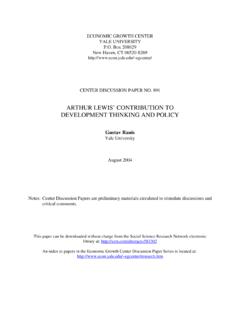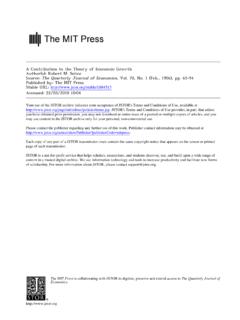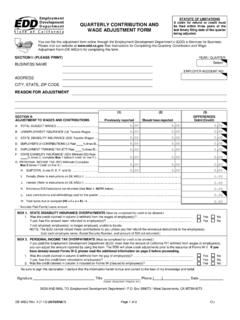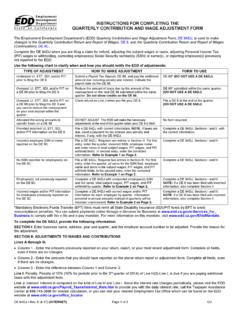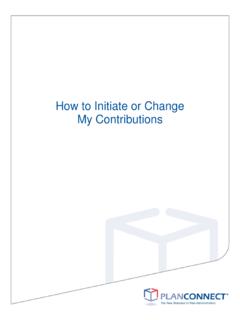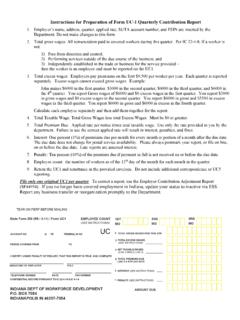Transcription of Defined Benefit Plans vs. Defined Contribution Plans
1 Defined Benefit Plans (DB) vs. Defined Contribution Plans (DC) Defined Benefit plan (traditional pension or fixed pension) A pension planunder which an employee receives a set monthly amount upon retirement, guaranteedfor their life or the joint lives of the member and their spouse. This Benefit may alsoinclude a cost-of-living increase each year during retirement. The monthly benefitamount is based upon the participant s wages and length of service. Defined Contribution plan A retirement savings program under which anemployer promises certain contributions to a participant s account during employment,but with no guaranteed retirement Benefit . The ultimate Benefit is based exclusivelyupon the contributions to, and investment earnings of the plan . The Benefit ceaseswhen the account balance is depleted, regardless of the retiree s age or circumstances.
2 Examples of such Plans are 457, 401(k), and 403(b) , wages for government and education employees have been lowerthan for the private industry. In return, retirement benefits have usually beenhigher. Switching to a DC plan and phasing out DB retirement benefits willrequire that wages increase in order to become more competitive, offsetting anypotential savings the employer may have realized from shifting to a DC only providing a retirement Benefit which is totally portable (such as a 401(k)or 457 plan ) government and education run the risk that highly-trainedemployees who had an incentive to remain in their careers due to a desire to earna 30 year retirement Benefit , will be willing to leave their positions foropportunities in the private sector. The result will be much higher turnover inpositions and less loyalty from senior employees, fewer experienced employeesand educators, and a more transitory workforce.
3 Also, there will be little institutional memory . a DC only Benefit will not eliminate the necessity of continuedmaintenance of the DB plan . The DB plan will need to be administered for thosecurrent retirees and also for all of those members who have vested service. (TheDB plan will require administration for the next 75+ years!) In addition, therewould be added administrative costs for running two Plans . Recent discussionsin California have focused on eliminating all public DB Plans and replacing themwith DC Plans . The consulting actuary for the California State TeachersRetirement System (CalSTRS) has projected that adopting a mandatory DC planwould increase required contributions by $900 million between years 2006 and2017. Not until the year 2028 will there be sufficient savings realized to coverthis increased Contribution .
4 This cost is for only one of the many retirementsystems in cost for the DB plan would climb if the plan is closed. This would be causedbecause there would be no new members entering the plan who may terminateprior to vesting, thus forfeiting their contributions and helping to fund thoseemployees who remain in the plan . Actuarially, a closed plan is more costlybecause there is a smaller population to spread the costs over. Also, the timehorizon over which costs can be spread is much shorter, meaning that costincreases must be funded over a shorter period resulting in much largerincreases. Governmental Accounting Standards Board Statement No. 25 alsorequires a shorter period for amortizing costs and unfunded liabilities, makingDB Plans which are closed much more expensive to administer. is a social cost for eliminating the DB plan .
5 If public employees do nothave enough income at retirement to support themselves, the welfare system ofthe state could be called upon to provide (Nebraska - see attached) has shown that DC only Plans produce asmaller Benefit at retirement than a DB plan , even when the same dollars areinvested. Nebraska s experience found that money which is managed andinvested by a professional staff into a DB plan earns higher returns, on average,than money invested by individual members into a DC plan . Even with 30 yearsof experience and training, DC participants do not invest as well, nor realizereturns as high as a professionally managed DB the DB plan is closed to new hires, the assumption then becomes that the DBplan is not set up in perpetuity and thus the time horizon of the investments willrequire a change to more liquid investments.
6 The allocation of investmentdollars to the top performing investment classes such as real estate and privateequity would need to be reduced or even eliminated, resulting in a decrease in thepotential return on investments, causing even more costs to fund the DB current retirement plan for public employees in Utah has both a DB and a DCcomponent. This balanced approach provides for a more secure retirementbenefit for participants than one which relies on a single option. The current DCplan allows members to select among various options for investing while stillbeing able to rely on stable retirement income from their DB plan . Eliminatingthe DB Benefit will place the member s entire retirement Benefit at the mercy ofmarket performance. is a key reason DC Plans are unreliable vehicles for ensuring retirementincome security.
7 Leakage refers to the loss of assets before retirement to suchfactors as loans (especially those that are not repaid by the participants) and bycashing out retirement savings when they change jobs (rather than leaving themin the existing plan - or by rolling them to an Individual Retirement Account or toa future employer s retirement plan ). Studies consistently indicate that half ormore of terminating participants fail to retain their retirement assets in aretirement savings account. a group, employees are generally poor investors, engaging in such practices asmarket timing, taking too much or too little risk, neglecting or over-managingtheir account, or not allocating their assets among different asset classes. Thefrequent result of these factors is insufficient retirement savings. Efforts toeducate workers regarding making better investment decisions often producedlimited success because of their unwillingness to take the necessary time or one-fourth of all public employees do not participate in Social Security,making their employer pension their primary source of financial security.
8 Switching their DB pension to a DC only plan will expose many of these workersto the dangers of insufficient retirement DB plan assists employers by promoting orderly turnover. DB Plans alsoenable participants to qualify for a Benefit on the basis of their age and service. In contrast, by determining retirement eligibility by the adequacy of savings, DCplans provide neither employers nor employees assurance of retirement eligibilitywhen employees would normally retire. This can result in employees remainingon the job long after their productivity has administrative cost of a DB plan is substantially lower than for a typical DCplan. The median cost of a DC plan is approximately (industry wide); themedian cost of a statewide DB plan is approximately The higher DC planexpenses reduces the assets available for benefits.
9 (Based upon informationpublished by the National Association of State Retirement Administrators.) employees prefer a DB plan . In recent cases in two large states Ohio andFlorida where large numbers of employees were given a choice between a DCplan and a DB plan , overwhelming percentages of workers chose to participate inthe DB DB plan is a life-time annuity which the member cannot out live. If themember chooses, a reduced Benefit may be selected, which provides a continuingbenefit to the spouse should the member predecease their spouse. is critical to the success of a DC plan . If a member retires in a downmarket, the funds withdrawn will reduce the principal upon which the memberwas relying to produce future investment earnings, resulting in either lowermonthly income or a shorter period of retirement income. Also, at the bottom ofa market cycle employees may not be able to afford retirement, regardless of theirage or Plans offer both disability as well as line-of-duty death benefits.
10 They mayalso offer a reduced lifetime Benefit for a surviving spouse if the member wasemployed for a minimum number of years, 15 years. DC plan benefits arebased only on the amount which has been deposited to and earned in theaccount. Members who are disabled or lose their life in a line-of-duty death earlyin their career will not have accumulated sufficient assets to support their spouseand Committee on Pensions and Investments, Texas House ofRepresentatives, Interim Report 2000: A Report to the House of Representatives 77thTexas Legislature, p. s Guide to Nebraska Retirement Systems, December , Jeff, The Wall Street Journal, State Worker s Pension Plans SparkDebate, May 5, s Experience with Defined Benefit and Defined ContributionPlans1 Nebraska presents an interesting case study in the DB/DC debate. While other stateshave recently adopted DC Plans , Nebraska adopted one over thirty years ago.
